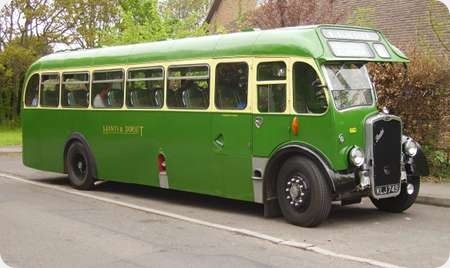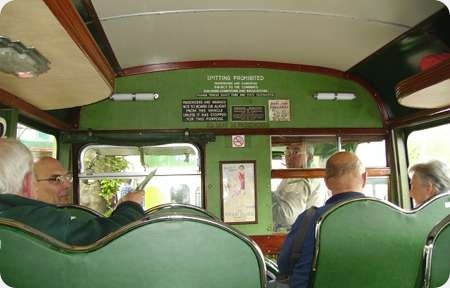Hants & Dorset - Bristol LL - KLJ 749 - 779
Hants & Dorset Motor Services
1950
Bristol LL6G
Portsmouth Aviation
DP36R
A Happy New Year to you all! It seems strange to hear that in May, but it was heard several times at Winchester on 4th May! Many enthusiasts and passers by gathered to give this Running Day a welcome at this new May date. The weather was certainly an improvement.
Illustrated here is Bristol LL6G KLJ 749, new to Hants & Dorset in 1950. It is unusual in having bodywork by Portsmouth Aviation (DP36R), one of ten supplied to Hants & Dorset in this batch. It is seen at Colden Common, before returning to The Broadway. The interior shot shows the multiplicity of notices displayed on the bulkhead.
Photograph and Copy contributed by Michael Hampton
19/05/15 - 06:11
Very nice photos of a fine bus, but-at the risk of being a tiresome pedant-I’m sure it’s an LL6G. That Garner 6LW makes it really fly along!
Ian T
19/05/15 - 06:13
A very handsome vehicle only slightly let down by the indicator box which
looks to be from an earlier era and the slope doesn’t help.
It looks to be beautifully
restored throughout but what a pity that a modern prohibition sign has been placed on the front
bulkhead pillar. ‘elf and safety no doubt rearing its ugly, pedantic head again.
Phil Blinkhorn
19/05/15 - 06:13
Thx for posting a view of this vehicle, Michael, which certainly gets around
in its dotage. It’s amazing how shades of art deco remained in coach design for quite a time after
the war.
Why on earth did Hants & Dorset go to Portsmouth Aviation to body these vehicles
rather than ECW, one wonders, although the finished article is attractive.
What do we know of
Portsmouth Aviation? I know nothing.
Chris Hebbron
19/05/15 - 07:46
The reason this didn’t have an ECW body was the length of the Gardner 6LW
engine. It required the front bulkhead to be further back and this would be a major change to a
standardised body that it appears ECW weren’t prepared to do.
As a consequence the numbers of
K6Gs and L5Gs were rather limited and all had ‘other’ body builders. The best illustration of
the difference can be found in the Pontypridd fleet as they had both Ls and Ks with 5- and
6-cylinder engines, all with Beadle bodies and the difference in engine can readily be seen in the
body.
David Beilby
20/05/15 - 06:05
I agree with Phil Blinkhorn’s comment re-the indicator box. I can’t help thinking that the effect is made worse by that H&D idiosyncrasy - the sun-visor over the driver’s windscreen. Was it really all that much more sunny in their territory than, say, Southern Vectis just across the water, or Southern National a bit farther west in Weymouth? I guess someone will come up with the reason for this appendage, and the name of him who decreed that all H&D buses must have one!
Stephen Ford
20/05/15 - 06:06
You’re quite right Chris- Art Deco seemed to be the decor of choice for coaches- especially half cabs- for a long time. The story of the Gardner engine is a glimpse of the past. It at first seems amazing that fleets of buses were obliged to use one chassis/coachbuilder and then that the coachbuilder should work on what later became a British Leyland principle of- effectively- dictating what your chassis was to be. How did the economics work? Were they negotiated contracts? And how, in reality, different are things in more recent times with Government telling you what sort of vast bussernaut to run? And how appropriate was tendering anyway? And were BET in reality any better than Tilling? Is it the case that civic pride and local councillor pressure often worked to passengers’ benefit in the municipalities? Questions, questions…
Joe
20/05/15 - 06:07
What a superbly handsome vehicle indeed with a glorious traditional high quality interior too. I do agree with Phil that the slope of the destination display might make for difficulty in reading, especially in certain bright conditions, but on balance I feel that the ECW "near vertical" pattern would have spoilt the look of the bus, particularly the flow of the roofline. The ECW type did though, of course, blend perfectly well with the Lowestoft design in what were, in my view, the finest looking and most practical front engined deckers of the postwar era.
Chris Youhill
23/05/15 - 07:11
Chris Hebbron asks about Portsmouth Aviation. I know little about this company
but browsed a book about it some years ago. Photographs showed rebuilding of the bodies of some of
Portsmouth Corporation’s Leyland TD4’s.
Examination of the Company’s website and Wikipedia
page shows that it is still in existence but not in the business of bus bodybuilding or
rebuilding.
Andy Hemming
24/05/15 - 07:33
Thx, Andy, for shedding a little more light; doing work on Portsmouth Corporation’s TD4’s. They must have been under pressure to farm out work like that.
Chris Hebbron
02/08/16 - 06:54
KLJ 749 is still going strong. It is owned by two members of the Bristol Vintage Bus Group and was a star turn at the Group’s running day on the 31st July, 2016. I was privileged to act as conductor/banksman on a number of trips. Its climbing ability with a full load was quite impressive
Jerry Wilkes
04/08/16 - 09:14
In response to Chris Hebbron’s enquiry about Portsmouth Aviation, here is a
bit of information, though the bus industry features only briefly in its history.
Portsmouth
Aviation was formed on 6 April 1929 as Inland Flying Services at Romford in Essex before moving in
May 1930 to a small airfield on the Isle of Wight at Apse Manor, near Shanklin, where it undertook
light aircraft maintenance work and offered pleasure flights. Meanwhile, in response to a 1928
government suggestion that all towns with a population of 20,000 or more should provide aviation
facilities, Portsmouth Airport, a municipal venture, was developed from 1930 on the north east
corner of Portsea Island. The first flight into the new airfield took place on 14 December 1930,
although the official opening did not occur until 2 July 1932. Inland Flying Services then
transferred its base to the new mainland airport and began operating a local air service to Ryde on
the Isle of Wight, adopting the new name of the Portsmouth, Southsea and Isle of Wight Aviation
Company. The inclusion of Southsea in the title was purely to encourage seaside custom; there was
never an airport there. The Ryde airfield was opened by PSIOWA in 1932, becoming fully operational
the following year. The company used typical aircraft of the period, amongst others the De Havilland
Moth, Puss Moth, Dragon, Westland Wessex and Airspeed Envoy (Airspeed had transferred its business
from York to Portsmouth in 1933). Developing rapidly, the firm began serving a number of air ferry
destinations around the south coast, at the same time expanding its aviation engineering,
maintenance and repair facilities. With the outbreak of hostilities in 1939, PSIOWA were ordered by
the government to cease the flying services and concentrate upon aircraft maintenance, repair and
modification duties, and this continued for the duration of the war. With the return of peace in
1946, PSIOWA changed its name to Portsmouth Aviation to reflect its core activities, but took on a
wider range of work beyond the air industry. One such new venture was the construction of commercial
vehicle bodywork to meet the post war surge in demand. It did, however, design and build one example
of the Portsmouth Aviation Aerocar Major, a pod fuselage, twin engined, twin boom machine for a
pilot and five passengers. The 1946 prototype was flown briefly in 1947 and exhibited at the 1948
and 1949 SBAC Farnborough Shows. Not having the resources for volume output, the firm made
arrangements for series production to be undertaken in India, but the plan fell through, and the
machine was scrapped in 1950. The bus bodywork side of the business fared rather better, with
deliveries of single deckers on Bristol chassis to Hants & Dorset and Wilts & Dorset, plus others on
Bedford OB chassis to the Independent sector. Remedial single and double deck bodywork attention was
undertaken, including some Aldershot & District Dennis Lances and Portsmouth Corporation TD4s. Some
Hants & Dorset lowbridge utility Guys are said to have been rebodied by the firm, but it is probable
that the original Brush bodywork was rebuilt. In 1950, Portsmouth Aviation, like many others,
dropped out of this declining market to concentrate on aviation and military business. The firm
still exists on the site today, but this is not the case with Portsmouth Airport itself which closed
in 1973 after some accidents that were attributed to the its inadequate size for modern aircraft. At
that time it was the last significant commercial airport still relying upon a grass runway.
Roger Cox
06/08/16 - 06:35
More than I could have hoped for, Roger, many thanks. FWIW, The airport was doomed when, during a wet summer and soggy grass, a Hawker Siddeley 748 on Channel Isles’ service skidded almost onto the dual-carriageway Eastern Road arterial road into Portsmouth, with its mate almost doing the same thing 45 mins later! Aircraft this large were banned shortly afterwards and another operator used three Twin Pioneer planes, painted red, blue and yellow, but not big enough to be profitable. This proved to be the airport’s deathknell. There was the opportunity to buy the closed Thorney Island RAF Station nearby, but Portsmouth Council said No and the more sensibly-sited Eastleigh (Southampton) Airport has taken over the mantle.
Chris Hebbron
Quick links to the - Comments Page - Contact Page - Home Page


